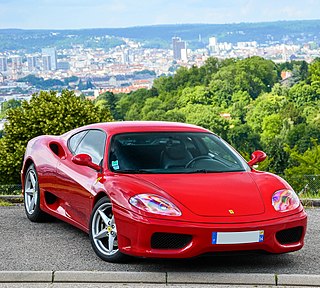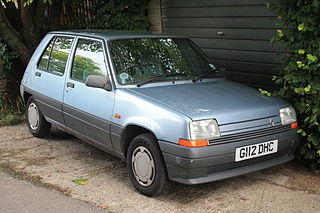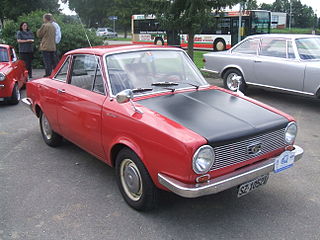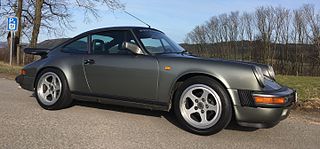Second generation
In January 1936 the New Primaquatre (Type ACL1) appeared, featuring with a new 2383 cc (14CV) engine providing up to 48 PS (35 kW; 47 hp) at 3200 rpm.
In following years the types ACL2, BDF1, BDF2 and BDS1 were introduced, and were produced until the early summer of 1940 when the unexpected speed of the German invasion put an end to most passenger car production in France. Two changes towards the end of 1937 were the introduction of Renault's newly developed mechanical brake servo, as well as the removal of one of the two access points for the fuel tank which from now on had to be filled using a single fuel filler on the right hand side of the rear panel. [1]
The last Primaquatre was the Primaquatre Sport (Type BDS2) with the 2.4-litre engine, [2] but with 56 PS (41 kW; 55 hp), type BDF2 receive the engine too of 62 PS (46 kW; 61 hp). One final technical enhancement came in 1940 when Lockheed hydraulic brakes replaced the cable brakes specified for the original design.

The Peugeot 504 is a mid-size, front-engine, rear-wheel-drive automobile manufactured and marketed by Peugeot from 1968 to 1983 over a single generation, primarily in four-door sedan and wagon configurations – but also as twin two-door coupé and cabriolet configurations as well as pickup truck variants.

The Porsche Carrera GT is a mid-engine sports car that was manufactured by German automobile manufacturer Porsche from 2004 to 2006. Sports Car International named the Carrera GT number one on its list of Top Sports Cars of the 2000s, and number eight on its Top Sports Cars of All Time list. For its advanced technology and development of its chassis, Popular Science magazine awarded it the "Best of What's New" award in 2003.

The Ferrari 360 is a two-seater, mid-engine, rear wheel drive sports car manufactured by Italian automotive manufacturer Ferrari from 1999 until 2004. It succeeded the Ferrari F355 and was replaced by the Ferrari F430 in 2004.

The Renault 5 is a five-passenger, three or five-door, front-engine, front-wheel drive hatchback supermini manufactured and marketed by the French automaker Renault over two generations: 1972–1985 and 1984–1996.

The Ferrari 575M Maranello is a two-seat, two-door, grand tourer manufactured by Italian automobile manufacturer Ferrari. Launched in 2002, it is essentially an updated 550 Maranello featuring minor styling changes from Pininfarina. The 575M was replaced by the 599 GTB in the first half of 2006.

The Ferrari F50 is a mid-engine sports car manufactured by Italian automobile manufacturer Ferrari from 1995 until 1997. Introduced in 1995, the car is a two-door, two seat targa top. The F50 is powered by a 4.7 L naturally aspirated Tipo F130B 60-valve V12 engine that was developed from the 3.5 L V12 used in the 1990 Ferrari 641 Formula One car. The car's design is an evolution of the 1989 Ferrari Mythos concept car.

The VQ is a family of V6 automobile petrol engines developed by Nissan and produced in displacements varying from 2.0 L to 4.0 L. Designed to replace the VG series, the all-aluminium 4-valve per cylinder DOHC design debuted with Nissan's EGI/ECCS sequential multi-point fuel injection (MPFI) system. Changes from the VG engine include switching to a timing chain from a timing belt, and relocating the water pump from the outside of the engine to inside the timing cover where the pump is driven by the timing chain. Later versions featured various improvements, such as variable valve timing, and NEO-Di designated VQ engines replace MPFI with direct fuel injection.

The Billancourt engine was an automotive engine designed by Renault for the Renault 4CV, used subsequently until 1985. It later received the internal code "B", for Billancourt. The "sport" version is called Ventoux engine.

The Lotus Exige is a sports car made by the British company Lotus Cars from 2000 until 2021. Originally a coupé version of the Lotus Elise roadster, since the Series 3 the Exige has been the larger-engined model of the family, featuring a V6 engine in place of the Elise's straight-four. Convertible versions of both models are available.
The San Storm is a two-seat Roadster from San Motors India LTD. of India that was introduced in 1998. It was designed by the French firm, Le Mans Group. It is powered by a 1149 cc Renault D7F engine driving the front wheels giving 60 bhp (45 kW) and a top speed of 144 km/h (89 mph). It has a double-skinned, fibreglass-reinforced tubular steel body and chassis, and the weight is only 760 kg (1,676 lb) giving it a quite satisfactory power-to-weight ratio. The time from 0 to 100 km/h (62 mph) is given as 13 seconds. The San Storm is assembled in Bangalore while the engine is mated to the bodywork in Goa.

The Porsche 911 GT2 is a high-performance, track-focused sports car built by the German automobile manufacturer Porsche from 1993 to 2009, and then since 2010 as the GT2 RS. It is based on the 911 Turbo, and uses a similar twin-turbocharged engine, but features numerous upgrades, including engine enhancements, larger brakes, and stiffer suspension calibration. The GT2 is significantly lighter than the Turbo due to its use of rear-wheel-drive instead of all-wheel-drive system and the reduction or removal of interior components. As a result, the GT2 is the most expensive and fastest model among the 911 lineup.

The Fiat 518, also called Fiat Ardita, was a model of car produced by Italian car manufacturer Fiat between 1933 and 1938. The name "Ardita" was also used on the six-cylinder engined and more expensive Fiat Ardita 2500 or 527.

The Opel 4 PS, popularly known as the Laubfrosch (treefrog), is a small two-seater car introduced by the auto maker Opel early in 1924. Subsequently, various versions of the little Laubfrosch were produced until it was replaced by the Opel 1.2 litre.

The Renault Celtaquatre is a small family car produced by the French manufacturer Renault between 1934 and 1938. Although French, it took some of its styling cues from American cars of the time. Its rounded silhouette gave it the nickname “Celtaboule” ("Celtaball").

The Monaquatre was a small family car assembled by Renault between 1931 and 1936. It used a conventional front-engine, rear-wheel-drive configuration and was powered by a four-cylinder water-cooled engine.

The Mercedes-Benz Mannheim 350 replaced the W03/Typ 350 models in 1929. The structure originated by Ferdinand Porsche was modified by Hans Nibel.

The Novaquatre is a car first presented in the autumn of 1937 by Renault and produced until 1940. It was presented in 1937 as an economy version of the Primaquatre, combining the body of the little Renault Celtaquatre, with the 2383 cc 4-cylinder water-cooled engine of the larger Renault Primaquatre.

The Mahindra Maxximo is a mini truck and a microvan that was manufactured by the Indian automaker Mahindra & Mahindra.

The Glas 1004 is a small two-door, four-seater automobile produced by Hans Glas GmbH at Dingolfing. It was first exhibited in public, in coupé form, at the Frankfurt Motor Show in September 1961. Volume production of the 1004 coupé started in May 1962, and in January 1963 saloon/sedan and cabriolet versions joined the range along with the more powerful Glas 1204. September 1965 saw a yet more powerful variant, the Glas 1304. In September 1966, a fastback Kombilimousine (estate) was added. The 04s were produced at least until December 1967, and new cars were listed for sale through much of 1968.

The Ruf SCR is a sports car manufactured by German automobile manufacturer Ruf Automobile. The SCR was based on the Porsche 911 SC and the changes made to its engine enabled it to have similar performance to the 930 Turbo, despite having a naturally aspirated engine.




















